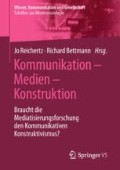Zusammenfassung
Anhand einer Auseinandersetzung mit einigen Grundlagen der ANT und vor allem deren Prinzip der Generalisierten Symmetrie wird versucht, eine kritische Ergänzung der Theorie des Kommunikativen Konstruktivismus zu gestalten, womit die Frage „inwieweit, in welchen Formen und mit welchen Folgen Medien an der kommunikativen Konstruktion der sozialen Wirklichkeit beteiligt sind?“ sinnvoller betrachtet werden kann. Von besonderer Bedeutung dabei ist das Paradox der Entfernung, das von Martin Heidegger damals in Bezug auf Fernsehen erwähnt wurde. Durch eine Fokussierung auf die Objektbezogenheit medialer Kommunikation werden einige Kant̛sche Voraussetzungen des Kommunikativen Konstruktivismus kritisch hervorgehoben, die aber für die Weiterentwicklung dieses Paradigmas – vor allem in Bezug auf seine gesellschaftstheoretische Bedeutsamkeit für die Analyse von mediatisierten Welten – ohne große Probleme zur Seite gelegt werden könnten.
Access this chapter
Tax calculation will be finalised at checkout
Purchases are for personal use only
Preview
Unable to display preview. Download preview PDF.
Literatur
Barthes, R. (1977). Image Music Text. London: Fontana.
Barthes, R. (1993). Camera Lucida. Reflections on Photography. London: Vintage.
Benjamin, W. (1973). The Work of Art in and Age of Mechanical Reproduction. In W. Benjamin (Hrsg.), Illuminations (S. 219—53). London: Fontana.
Berger, P.L., & Luckmann, Th. (1966). The Social Construction of Reality. Hammondsworth: Penguin Books.
Bolter, J. D., & Grusin. R. (1999). Remediation: Understanding New Media. Cambridge MA: MIT Press.
Callon, M. (1986). Some Elements of a Sociology of Translation: Domestication of the Scallops and the Fishermen of St Brieuc Bay. In J. Law (Hrsg.), Power, Action and Belief: A New Sociology of Knowledge (S. 193—233). London: Routledge & Kegan Paul.
Daston, L., & Galison, P. (2010). Objectivity. New York: Zone Books.
Derrida, J. (1974). Of Grammatology (transl. G. Chakravorty Spivak). Baltimore: Johns Hopkins University Press.
Durkheim, É. (1894). Les Règles de la Méthode Sociologique. Paris: Payot.
Foucault, M. (1969). L’ Archéologie du Savoir. Paris: Éditions Gallimard.
Foucault, M. (1971). L’order du discours. Paris: Gallimard.
Foucault, M. 1978/1990. The History of Sexuality, an intro duction; volume 1 (transl. R. Hurley). New York: Random House.
Garfinkel, H. (1967). Studies in Ethnomethodology. Englewood Cliffs: Prentice Hall.
Glaser B.G., & Strauss, A. (1967). Discovery of Grounded Theory. Strategies for Qualitative Research. Sociology Press.
Goffman, E. (1973). Frame Analysis. An Essay on the Organization of Experience. Cambridge Mass.: Harvard University Press.
Goody, J. (1975). Literacy in Traditional Societies. Cambridge: Cambridge University Press.
Han, B.-Ch. (2012). Die Transparenzgesellschaft. Berlin: Matthes & Seitz.
Heidegger, M. (1977). The Question Concenring Technology and Other Essays. New York: Harper & Row.
Heidegger, M. (1986). Sein und Zeit. 16. Aufl. Tübingen: Max Niemeyer.
Innis, H. (1950). Empire and Communications. Oxford: Clarendon Press.
Keller, R. (2005). Wissenssoziologische Diskursanalyse. Grundlegungen eines Forschungsprogramms. Wiesbaden: VS Verlag.
Keller, R., Knoblauch, H., & Reichertz, J. (Hrsg.). (2013). Kommunikativer Konstruktivismus: Theoretische und empirische Arbeiten zu einem neuen wissenssoziologischen Ansatz. Wiesbaden: Springer.
Kittler, F. (1997). Literature Media Information Systems. Amsterdam: OPA.
Krackauer, S. (1960). Theory of Film. The Redemption of Physical Reality. New York: Oxford University Press.
Krotz, F., & Hepp, A. (Hrsg.). (2012). Mediatisierte Welten. Forschungsfelder und Beschreibungsansätze. Wiesbaden: Springer Verlag.
Kunzmann, R. W. (1982). Friedrich Nietzsche und die Schreibmaschine. Archiv für Kurzschrift, Maschinenschreiben, Bürotechnik 3.
Latour, B. (2005). Reassembling the Social. An Introduction to Actor Network Theory. Oxford: Oxford University Press.
Levinson, P. (1997). The Soft Edge. A Natural History and Future of the Information Revolution. London: Routledge.
Levinson, P. (1998). Digital McLuhan. A Guide to the Information Millennium. London: Routledge.
Lury, C. (1998). Prosthetic Culture; Photography, Memory and Identity. London: Routledge.
McLuhan, M. (1964). Understanding Media: The Extensions of Man. New York: Penguin.
Mersch, D. (2006). Medientheorien: zur Einführung. Berlin: Junius.
Nietzsche, F. (1992). Der Wille zur Macht. Frankfurt am Main: Insel-Verlag.
Ong, W. (1982). Orality and Literacy. The Technologizing of the World. London: Routledge.
Poferl, A., & Schröer, N. (Hrsg.). (2014). Wer oder was handelt? Zum Subjektverständnis der hermeneutischen Wissenssoziologie. Wiesbaden: VS Verlag.
Postman, N. (1987). Amusing Ourselves to Death. Public Discourse in the Age of Show Business. London: Methuen.
Reichertz, J. (2009). Kommunikationsmacht. Was ist Kommunikation und was vermag sie? Und weshalb vermag sie das? Wiesbaden: VS Verlag.
Reichertz, J. (2017). Die Bedeutung des kommunikativen Handelns und der Medien im Kommunikativen Konstruktivismus. Themenheft von Medien & Kommunikationswissenschaft. Baden-Baden: Nomos. S. 252-274.
Schütz, A., & Luckmann, Th. (1984). Strukturen der Lebenswelt. Frankfurt am Main: Suhrkamp Verlag.
Spöhrer. M., & Ochsner, B. (Hrsg.). (2017). Applying the Actor-Network Theory in Media Studies. Hershey PA: IGI Global.
Teurlings, J. (2017). What Critical Media Studies Should Not Take from Actor-Network Theory. In M. Spöhrer & B. Ochsner (Hrsg.), Applying the Actor-Network Theory in Media Studies (S. 66—78). Hershey PA: IGI Global.
Van Loon, J. (2008). Media Technology: Critical Perspectives. Maidenhead: McGraw-Hill Open University Press.
Van Loon, J. (2017). The Subject of Media Studies. In M. Spöhrer & B. Ochsner (Hrsg.), Applying the Actor-Network Theory in Media Studies (S. 51—65). Hershey PA: IGI Global.
Weber, M. (1922/1956). Wirtschaft und Gesellschaft. Grundriss der verstehenden Soziologie. 4. Auflage. Tübingen: Mohr.
Winthrop-Young, G. (2005). Friedrich Kittler zur Einführung. Berlin: Junius.
Author information
Authors and Affiliations
Corresponding author
Editor information
Editors and Affiliations
Rights and permissions
Copyright information
© 2018 Springer Fachmedien Wiesbaden GmbH, ein Teil von Springer Nature
About this chapter
Cite this chapter
van Loon, J. (2018). Akteur-Netzwerke der Medialität. In: Reichertz, J., Bettmann, R. (eds) Kommunikation – Medien – Konstruktion. Wissen, Kommunikation und Gesellschaft. Springer VS, Wiesbaden. https://doi.org/10.1007/978-3-658-21204-9_9
Download citation
DOI: https://doi.org/10.1007/978-3-658-21204-9_9
Published:
Publisher Name: Springer VS, Wiesbaden
Print ISBN: 978-3-658-21203-2
Online ISBN: 978-3-658-21204-9
eBook Packages: Social Science and Law (German Language)

